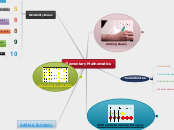Elementary Mathematics
Adding Bases
Dividing Fractions
Fractions to Decimals
Cornell notes
Connections
Share the connections you found while working
Formula Vocabulary
Write out any important formulas and/or vocabulary terms in relation to lesson
Equation/Problem
Write the equation or problem out
Problem worked out
1st color of your choice: usually the color you wrote the equation in the section next to it. rewrite equation.
Ex: 5-9x=3-4x
Add 9 to both sides of the equal sign to combine like terms with 4x. Bring down the 5 and = sign with 3+5x. 5=3+5x
Now subtract 3 to both sides so you're left with, 2=5x.
With your last color is the lastt step: you divide 5 to both side and end up with. x=2/5.

Adding/ Subtracting Integers
Divisibility Rules
2
Even numbers in the ones place value that is a evens. Show a student by the place values and not by saying the end of the number.
Example: 1546 the ones place value is an even number
3
Add all the digits if answer is divisible by 3. If it is a number over a hundred, you will separate each digit and add together to see if it results to a number that is divisible by 3.
Example: 474
4+7+4 =15 (Which is divisible by 3).
4
The last two digits are divisible by 4. No matter how large the number is, the last two digits (Tenths & ones place values) will by divisible by 4.
Example:34,117,916
16 are the last two digits in this number and 16 is divisible by 4.
5
Number ends in a zero or a 5 itself.
Example: 74,825
6
If a number is divisible by 2 and 3 than it is divisible by 6.
Example: 12
8
The last 3 digits are divisible by 8.
Example: 52,864
9
Add the digits divisible by 9. Just like number 3 rules above.
10
If a number ends in Zero.
Example: 20.
30
40

Division by primes

Adding Fractions

